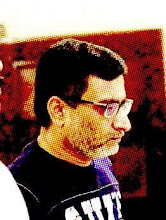It is no doubt that we learn to draw by drawing. more often we hit a plateau and find it hard to jump up to the next level. Over the years I have been reading, and tyring to learn from various texts and references on how to draw. while there is always something to learn from every book, there are certain books from great teachers, which will always take one to the next level. I list three such authors here, who I guarantee will make an impact.
(1) The Natural Way to Draw by Kimon Nicolaides
 This book would create an impact, no matter at what level one is in their drawing ability. After a long period of lull this created a storm in my artistic endeavor. It is a great place to begin, since it teaches the foundation of art, how one should approach drawing, what is it you draw, what is it that you strive to capture, what is it that you create. Using the simplest of the tools - a scribble, one begins to draw. everybody can scribble. and that's all you need to begin learning how to draw. Gesture, weight and modelling are three fundamental aspects that can be captured by deep observation, and just scribbling. and by practicing this, you can draw anything and everything that you see and over a period of time just from your mind!
This book would create an impact, no matter at what level one is in their drawing ability. After a long period of lull this created a storm in my artistic endeavor. It is a great place to begin, since it teaches the foundation of art, how one should approach drawing, what is it you draw, what is it that you strive to capture, what is it that you create. Using the simplest of the tools - a scribble, one begins to draw. everybody can scribble. and that's all you need to begin learning how to draw. Gesture, weight and modelling are three fundamental aspects that can be captured by deep observation, and just scribbling. and by practicing this, you can draw anything and everything that you see and over a period of time just from your mind!
(2) Vilppu Drawing Manual by Glenn Vilppu



In a series of chapters , one building on top of the other, Vilppu teaches every aspect of drawing, and introduces the basic tools needed to draw. Vilppu says, drawing is all about capturing gesture and form. Representing 3 dimensional form in two dimensional paper. drawing is all about capturing and creating form, the relations between other forms. How you go about doing this, is all that Vilppu talks about with countless illustrations. Gesture, Form, Light and shade,Atmosphere and so on are different aspects that make the picture more and more convincing. Vilppu introduces simple tools such as Sphere, Box, Cylinder and combine them to create complex forms. these are techniques that come down from the great masters of the renaissance.
(3) Figure Drawing books by Burne Hogarth


At this stage we understand how to go about drawing. mostly we become good at drawing from observation. and possibly retain some knowledge and recreate from the mind.



But if one were to understand the details of the complex human figure, one need to study the wonderful books from Hogarth. Nowhere else one can find such clear renderings of the human form, so easy to understand and hence so easy to add to our mental library of reference. Hogarth analysis the human form in such detail and clarity, all it takes is one look.
By studying the numerous drawings and constantly practicing them, and creating our own actions and figures, one can produce stunningly realistic human figures.
And then of course we need to draw, all the time, from life and from imagination to hone our skills. There are so many subjects, animals, nature, numerous man made stuff and so on for which we seek other teachers, books and references. But these three authors will create a definite impact on the way we go about drawing and will set us on a strong foundation.









































